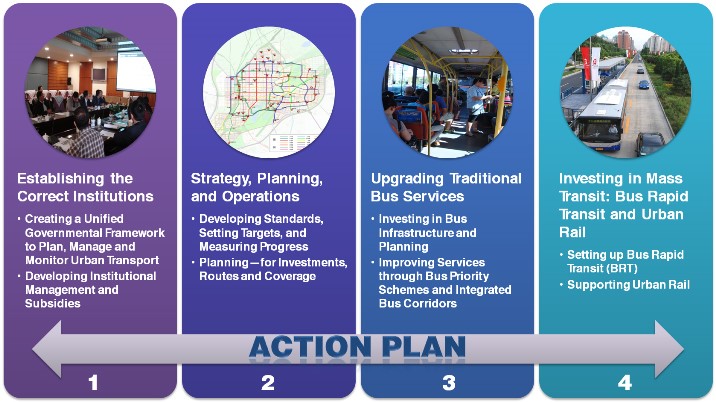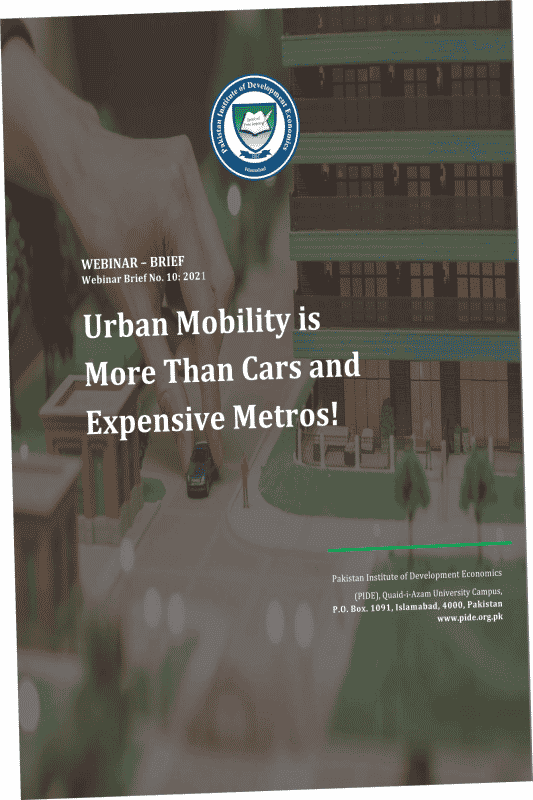
Pakistan Institute of Development Economics
- Home
Our Portals
MenuMenuMenuMenuMenuMenuMenu - ResearchMenuMenuMenuMenuMenuMenuMenu
- Discourse
- The PDR
- Our Researchers
- Academics
- Degree Verification
- Thesis Portal
- Our Portals
Urban Mobility Is More Than Cars And Expensive Metros!
Urban Mobility is More Than Cars and Expensive Metros!
KEY POINTS.
What should be the ideal vision of urban transport policy?
- For this, first we have to study the urban transport policy progression and how it evolves globally. Nowadays, the urban transport system is accessibility based which evaluates the system on the ability of both people and business to access the desired services and activities (Litman, 2020). Accessibility is the main driver of cities growth and development.
What should be the aim(s)/objective(s) of the urban transport policy?
- Urban transport system that provides equal mobility opportunity for all segments of the society.
- Access to opportunities, jobs, and amenities needed for cities to serve as engines of growth.
- Connected cities with multiple mobility options, strictly discourage reliance on a single mode.
- Integrate transport with urban planning to reduce commuting distances and optimize expenditures.
- Smart technology-based initiatives to lead decision- making of transport development processes.
- Explore potential revenue sources for urban agencies to avoid dependence on higher tier governments.
- Improve environmental parameters significantly by regulating transport-related causes of climate change and global warming.
- Design of urban streets to be safe, with universal challenges and deliver quality projects in time.
- Increase contractor skills to deal with the urban challenges and deliver quality products in time.
- Standardization of urban transport operations like licensing, vehicle fitness testing, automated violation monitoring, parking management, and congestion pricing, among several other operations.
Urban Development Practices: Global VS Local
GLOBAL | LOCAL |
Connected/compact Cities | Sub Urban Sprawl |
Cross sector collaboration | Focus on Car’s speed/LOS |
Create jobs through mix used development | Focus on single unit housing only |
Shorter trip lengths | Loner trip length due to lack of facilities |
Maintain healthy lifestyle | Reliance on motorized vehicles |
Minimize carbon footprints | Noise and air pollution from motorized vehicles |
Mobility or Accessibility Options
There are different options of mobility available to the public such as motorized and non-motorized. Motorized transport modes consist of private cars, motor bikes, buses, BRT, metro and paratransit. On the flip side, non-motorized modes include bike cycle, walking and e-bikes.
- Streets or ROW consist of 60~90% of Public space in city & Pak cities will be on the higher side (90%) due to lack of other public spaces.
- How we manage streets determine the shape of the city.
- Streets or Right-of-Way (ROW) are public spaces that connect people to facilities.
Transport Planning in Pakistan Cities
According to the population census 2014, and Pakistan Bureau of Statistics 2017, the population of Pakistan will be doubled by 2050. However, unfortunately, urban transport is in crisis from the last decades. Further, tremendous upsurge in the use of private vehicles is adversely impacting the mobility options. Therefore, local governments need to have a realistic plan to fulfil future mobility needs. So that cities can be both livable as well as engines of growth. The following measures could be considered while making transport planning for cities.
- Investment in transport infrastructure to be smart, effective and based on people’s needs while considering several alternate scenarios.
- Integrated planning is needed to minimize urban travel distances and long-distance trips to be strictly discouraged and to optimize the heavy investments in transport infrastructure.
- At Pre- development stage, the urban planning to target integrated communities or sustainable districts, so maximum trips happening in developments are served within developments and to limit the impact on urban transport infrastructure.
- At Post- development stage, (For existing urban areas and downtown) urban planning process to continue evaluating the land use pattern and identify shortages in specific facilities causing the significant number of long-distance trips. Mitigate the shortage of specific urban land use by adding the required urban facilities and revision in regulations where needed.
Urban Transport Issues in Pakistan
- Urban transport is not considered as a specialized discipline in most civic agencies.
- Civic agencies lack capital, human resources, vision, skills and are bound by legislation.
- No local standards or design guide for Urban planning, transport planning and street design.
- Lack of diverse projects experience for clients (gov, public), consultant and contractor side.
- No leading urban infra firms like AECOM, JACOBS, KEO, PARSONS are available to fill the technical gap in Urban and transport planning.
- Limited no of firms lacks competitiveness, quality resulting in sub standard output
- Project based approach (which is always short term).
- Even on the technical side, People with construction or structure background are leading processes. Highway design engineers are not well aware of urban street design.
- Professional engineering license not mandatory to practice engineering/planning.

- To recapitulate, Pakistan has a very high rate of urbanization and when the population in cities rises around 8 to 10 percent per annum, the burden on any planning authority also increases. Resultantly, the service delivery becomes difficult. Therefore, we should develop secondary cities to decrease the pressure on existing cities.
- In Pakistan, the transit issue is not from demand side failure, but it is a supply side failure. On the supply side, the government and private entrepreneurs do not want to provide the proper transit to the people. The reason behind this is the lack of information about transit from both people and institutions.



